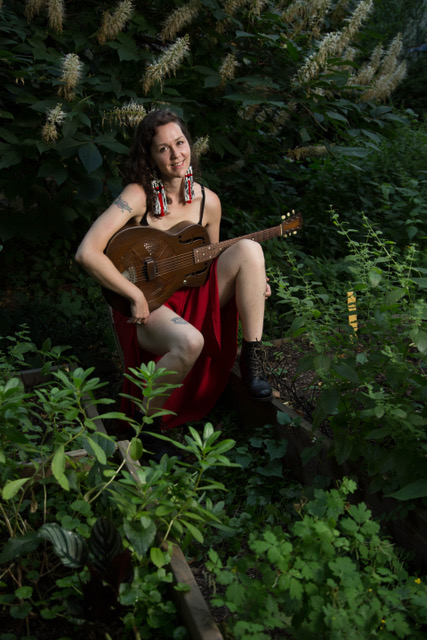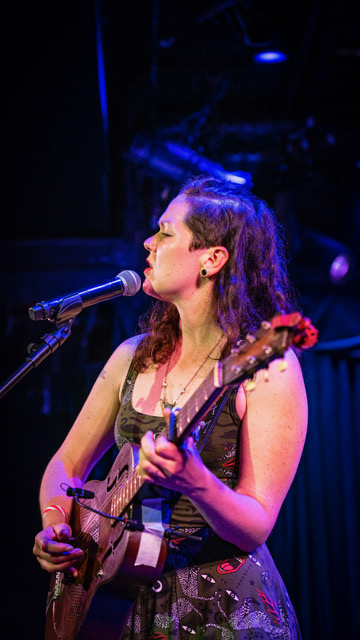Great things are happening on the New York roots music scene. Meet the freewheeling chanteuse Mamie Minch, a trailblazing independent singer/songwriter and one of the important acoustic blues women in the US.
The first thing noticeable when speaking to Mamie Minch, residing in the Lower Eastside of Manhattan, is her exceptional voice. She could be a radio host, articulating and projecting her tonality like a professional voiceover narrator, each syllable clear, with perfect diction. No wonder she sings so well with a rich, emotive folk & blues voice, with more than a hint of tactile sensuality befitting the genre.
She has the perfect name for a roots & blues singer, but despite the appropriate leap back to the great blues singer Mamie Smith from the 1920s, it’s not a concocted stage name. She’s named after her great-grandmother. A fortuitous inheritance for a singer/songwriter!

Her music is a swift mix of acoustic roots & blues, Americana and ‘deep folk’ with a down-to-earth, easy vibe, natural and organic. No gimmicks or pretenses. It’s all creative substance and instrumental prowess. When she gets going you can tell in three seconds flat that she’s the real deal – a bold, strong, confident woman, self-assured in her artistry, message and musicality. All that idiomatic richness, plus she is a top tier alternating bass fingerpicking guitarist with lovely, impressively smooth and refined technique. She tells, “I play a 1937 National Duolian. It sounds great. It can have that growling resonator sound, or even a warmer, more acoustic sound, depending on how I drive it. I play in standard, open G and open D for the most part.”
Minch was born in Virginia and grew up in Wilmington, Delaware. She dropped out of high school at sixteen. Like many naturally creative and individualistic folks, she ended up going to art school for four years, in her case at the Columbus College of Art and Design. She explains, “It was a traditional teaching art school, with a lot of rigorous drawing classes. I ended up doing printing and other image-making collages. In 2002, I came to New York in my senior in year. A special scholarship program allowed me to have a studio. I ended up staying here and joined a band…I had spent my teenage years playing a lot of country blues. It was a very solitary thing for me. When I got to New York, I found this community of people who knew all the words to Bessie Smith. It was really great. I joined a band called Delta Dreambox with a woman named Bliss Blood when I was living in Green Point, Brooklyn.”
“I learned to play guitar as a teenager – 12 or 13. My dad was a guitar player and had a nice guitar hanging around. He said, “Sure, I’ll let you play this if you learn a few chords.” He gave me a hundred bucks, and I made a hundred bucks, and I went out and bought a $200 Washburn guitar. I started to learn Mississippi John Hurt songs, fingerpicking from the beginning. My dad gave me a few lessons. My biggest influences when I was learning were Mississippi John Hurt, Son House, Booker White, Memphis Minnie. I also really love Ike Turner and Richard Thompson. My musical education was lots of fingerpicking blues, maritime folk songs and the stuff that my peers were listening to. There was a hot live music scene of kids playing punk rock and hardcore music. So those were my two loves: listening to this acoustic gentle finger-style music and then this much heavier, harder stuff.
If all that wasn’t achievement enough, she is also a successful artisan entrepreneur, a business partner in the only women-owned and operated instrument repair shop in New York City, Brooklyn Lutherie, located in the Old American Can Factory in Gowanus, Brooklyn. “My artwork parlayed into my other career as a luthier. I do restoration and repair on stringed instruments. That’s my day job. I was doing these very processed, very heavy visual art and also playing music. I found that working on guitars – doing restoration work – is a little bit like a marriage between the two things, art and music. You have to be very careful, it’s slow, it’s specific. I took to it really well. I’ve been doing that now for almost 20 years. Business is always good. This city is filled with musicians, and where you have musicians you have broken instruments. It’s basically as much work as we can handle. There’s two of us and we have two employees. It’s a shop of four.”

Minch performs a mix of covers and exciting originals, with an interesting body of recorded work, “I have always written songs by using the vocabulary of the early blues. I came out with my first solo record Razorburn Blues in 2008, a collection of songs that I’ve learned from old records and songs that I’ve written, using a lot of intimate vocabulary. I had a little help on the bass from Andy Cotton. Karen Waltuch played viola and Patrick Farrell, a friend of mine, joined on accordion.”
Recently, she has been working solo, often supported by drummer Dean Sharenow. “I play songs that I’ve written and early blues that I reworked. I love this woman Connie Converse, a folk singer from the 1950s. I’ve done some sets of just her work. I usually incorporate a song or two of hers into my set.” In 2020, Minch released the album Slow Burn with Dean Sharenow. On this record, she aptly updated R.L. Burnside’s Mississippi Hill Country blues song Poor Black Mattie, reimagining poor Mattie as empowered, renaming the song “Big Bad Mattie.” Minch infused a form of symbolic emancipation on Mattie, projecting her own feminist perspective. That takes some hutzpah but it makes good sense. No submissive femme fatale stuff for Mamie Minch, who thinks for herself and stands on her own feet. The bard explained, “I changed it into a story that felt more comfortable – good for me to sing. In my version of the song, she’s in charge, she’s setting the rules. She owns her life and her sexuality and she’s no longer kind of a poor thing that’s been left outdoors…I love talking about historical women and blues. I like thinking about the way that loving an old art form like this, that’s actually part of our contemporary lives, is so interesting and rich, absent of nostalgia. I feel like modernizing it and making it more feminist, reflecting my own life, my own identity as a modern white woman living in a city. It is very different to be living in the South and poor and black back in the time when many of these records were made. So how do you support and celebrate and be respectful of these artists and also dive into the dream with them and continue to work? The way I move around in the world is feminist and political. So that’s how I understand my job as being a modern artist who was influenced by the blues. It doesn’t make sense for me to sing certain lyrics – they don’t apply to me; they’re not about me. Some of them are just not appropriate. If you have an opportunity to decide what is appropriate – what do you want to sing? Then you become part of the story, part of the story of American music and blues music.”
Minch has released several exciting independent records, including the 6-song EP Songs for Hazel with Dayna Kurtz, coveringHazel Dickens. “We decided to cover songs that she covered and songs that she’d written that were less like protest songs, less about her activism and her political work and were more the love songs that she had written, because they’re just devastating love songs.”
She is a vital member of the vibrant New York City roots & blues scene, “I played with Meg Reichardt for a long time. We were the two first members of the Roulette Sisters. I also play with Tamar Korn, a magical, whimsical, wonderful New York-based jazz, blues singer. We’ve had a long collaboration – about 15 years. We sing in harmony and things get interesting. There might be some throat singing involved, or some vocals with fiddle and banjo.” In 2018, Korn and Minch released the fun EP Jalopy Records 7″ Series: Mamie Minch & Tamar Korn. Currently, Minch is also involved in an instrumental collaboration with Stephen Ulrich, an internationally renowned brilliant ,virtuosic New York guitarist whose band is Big Lazy – two guitars scoring silent films that a third friend creates. They call the project “Filmic Music.”
Make it a point to see a Minch show during your next visit to New York. Her “home base” is Barbes, a club in Park Slope, Brooklyn, where she’s been playing for 20 years. On top of her performing and day job, partnering in a successful luthier business, she is the also a guitar teacher and the organizer of an acoustic guitar camp at Ashokan in Olive Bridge, New York, run by Jay Unger and his wife Molly Mason.
Keep your ears on this artist, one of New York’s finest. Great things are to come!


###